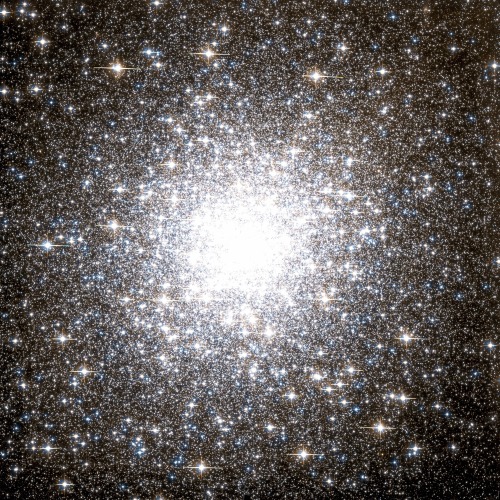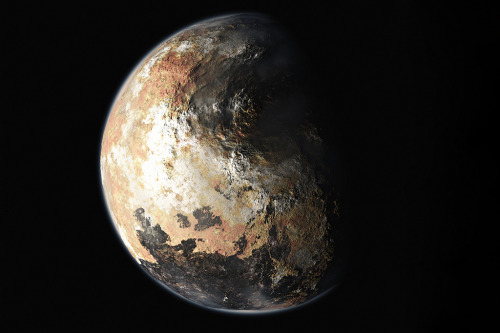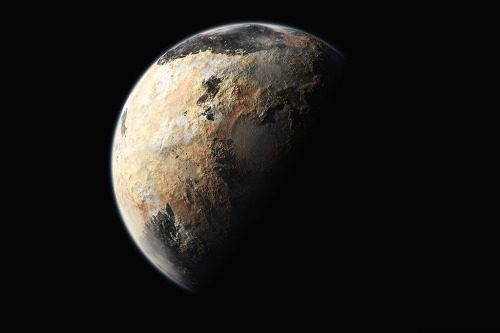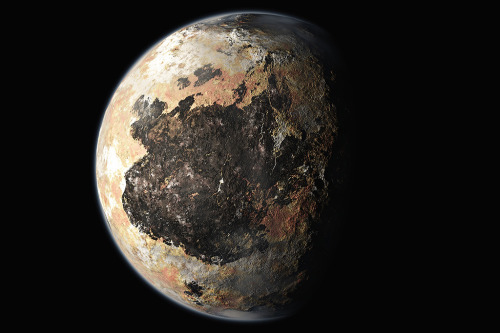Bubble Nebula By Hubble Heritage Via Flickr: For The 26th Birthday Of NASA’s Hubble Space Telescope,
Bubble Nebula by Hubble Heritage Via Flickr: For the 26th birthday of NASA’s Hubble Space Telescope, astronomers are highlighting a Hubble image of an enormous bubble being blown into space by a super-hot, massive star. The Hubble image of the Bubble Nebula, or NGC 7635, was chosen to mark the 26th anniversary of the launch of Hubble into Earth orbit by the STS-31 space shuttle crew on April 24, 1990. The Bubble Nebula is 7 light-years across — about one-and-a-half times the distance from our sun to its nearest stellar neighbor, Alpha Centauri. The Bubble Nebula was discovered in 1787 by William Herschel, a prominent British astronomer. It is being formed by a prototypical Wolf-Rayet star, an extremely bright, massive, and short-lived star that has lost most of its outer hydrogen and is now fusing helium into heavier elements. The star is about 4 million years old, and in 10 million to 20 million years, it will likely detonate as a supernova.
Credit: NASA, ESA, and the Hubble Heritage Team (STScI/AURA) heritage.stsci.edu/2016/13/ hubbledev.stsci.edu/newscenter/archive/releases/2016/13/
More Posts from Littlecadet-biguniverse and Others

Hubble views a spectacular supernova with interstellar material over 160,000 light-years away by NASA Goddard Photo and Video on Flickr.
This NASA/ESA Hubble Space Telescope image captures the remnants of a long-dead star. These rippling wisps of ionized gas, named DEM L316A, are located some 160,000 light-years away within one of the Milky Way’s closest galactic neighbors — the Large Magellanic Cloud (LMC). The explosion that formed DEM L316A was an example of an especially energetic and bright variety of supernova, known as a Type Ia. Such supernova events are thought to occur when a white dwarf star steals more material than it can handle from a nearby companion, and becomes unbalanced. The result is a spectacular release of energy in the form of a bright, violent explosion, which ejects the star’s outer layers into the surrounding space at immense speeds. As this expelled gas travels through the interstellar material, it heats up and ionizes it, producing the faint glow that Hubble’s Wide Field Camera 3 has captured here. The LMC orbits the Milky Way as a satellite galaxy and is the fourth largest in our group of galaxies, the Local Group. DEM L316A is not the only supernova remnant in the LMC; Hubble came across another one in 2010 with SNR 0509, and in 2013 it snapped SNR 0519. Image credit: ESA (European Space Agency)/Hubble & NASA, Y. Chu

NGC 3576, an emission nebula in the constellation of Carina 6,000 light years away. -image via paulhaese.net

Galaxy Trio Arp 286:
NGC 5566 (bottom), NGC 5569 (left), & NGC 5560 (center)

150,000 Stars - The Messier 2 Star Cluster
This massive Star Cluster (The Messier 2 Star Cluster) is 13 billion years old - making it one of the oldest star clusters in the Milky Way Galaxy. Not only is this Star Cluster ancient, it is one of the largest known star clusters. On a clear night away from light pollution, you can see M2 with the naked eye as a faint blur in the constellation Aquarius.
Credit: NASA/Hubble/SIMBAD Astronomy db

Island Point Milky Way
Nikon d5100 - 6 x 25s - ISO 4000 - f2.8 - 16mm

What forms lurk in the mists of the Carina Nebula? The dark ominous figures are actually molecular clouds, knots of molecular gas and dust so thick they have become opaque. In comparison, however, these clouds are typically much less dense than Earth’s atmosphere. Featured here is a detailed image of the core of the Carina Nebula, a part where both dark and colorful clouds of gas and dust are particularly prominent. The image was captured last month from Siding Spring Observatory in Australia. Although the nebula is predominantly composed of hydrogen gas – here colored green, the image was assigned colors so that light emitted by trace amounts of sulfur and oxygen appear red and blue, respectively. The entire Carina Nebula, cataloged as NGC 3372, spans over 300 light years and lies about 7,500 light-years away in the constellation of Carina. Eta Carinae, the most energetic star in the nebula, was one of the brightest stars in the sky in the 1830s, but then faded dramatically.
Object Names: Carina Nebula
Image Type: Astronomical
Credit: John Ebersole
Time And Space

Andromeda glowing in infrared.

-
 the-nights-gaze reblogged this · 2 years ago
the-nights-gaze reblogged this · 2 years ago -
 mustachemojo reblogged this · 3 years ago
mustachemojo reblogged this · 3 years ago -
 mustachemojo liked this · 3 years ago
mustachemojo liked this · 3 years ago -
 ambrysia liked this · 4 years ago
ambrysia liked this · 4 years ago -
 sthlazyandsarcastic liked this · 6 years ago
sthlazyandsarcastic liked this · 6 years ago -
 maryspear liked this · 7 years ago
maryspear liked this · 7 years ago -
 nervous-constelation liked this · 7 years ago
nervous-constelation liked this · 7 years ago -
 arthuromp-blog liked this · 7 years ago
arthuromp-blog liked this · 7 years ago -
 chbnb liked this · 7 years ago
chbnb liked this · 7 years ago -
 justpeachybabey liked this · 8 years ago
justpeachybabey liked this · 8 years ago -
 chaosmarri liked this · 8 years ago
chaosmarri liked this · 8 years ago -
 mielyoro liked this · 8 years ago
mielyoro liked this · 8 years ago -
 lacsdesprit liked this · 8 years ago
lacsdesprit liked this · 8 years ago -
 kretinojungiano liked this · 8 years ago
kretinojungiano liked this · 8 years ago -
 black-star1472 liked this · 8 years ago
black-star1472 liked this · 8 years ago -
 clexacity liked this · 8 years ago
clexacity liked this · 8 years ago -
 inglourious91 liked this · 8 years ago
inglourious91 liked this · 8 years ago -
 salvatorec90-blog liked this · 8 years ago
salvatorec90-blog liked this · 8 years ago -
 schaafvirgo liked this · 8 years ago
schaafvirgo liked this · 8 years ago -
 justaway11 liked this · 8 years ago
justaway11 liked this · 8 years ago -
 iris-rainbowflower reblogged this · 8 years ago
iris-rainbowflower reblogged this · 8 years ago -
 interegnum reblogged this · 8 years ago
interegnum reblogged this · 8 years ago -
 the0phrastus liked this · 8 years ago
the0phrastus liked this · 8 years ago -
 alleycat57 liked this · 8 years ago
alleycat57 liked this · 8 years ago -
 ihavecripplingosteoporosis-blog liked this · 8 years ago
ihavecripplingosteoporosis-blog liked this · 8 years ago -
 th0ca liked this · 8 years ago
th0ca liked this · 8 years ago -
 set-saiil liked this · 8 years ago
set-saiil liked this · 8 years ago -
 aarianaperez-blog liked this · 8 years ago
aarianaperez-blog liked this · 8 years ago -
 irl-sportacus reblogged this · 8 years ago
irl-sportacus reblogged this · 8 years ago -
 tboytoby liked this · 8 years ago
tboytoby liked this · 8 years ago -
 rawrrcolleen-blog liked this · 8 years ago
rawrrcolleen-blog liked this · 8 years ago -
 jakrupke62 liked this · 8 years ago
jakrupke62 liked this · 8 years ago -
 radhamr liked this · 8 years ago
radhamr liked this · 8 years ago -
 a-secretkey reblogged this · 8 years ago
a-secretkey reblogged this · 8 years ago -
 cactbi reblogged this · 8 years ago
cactbi reblogged this · 8 years ago -
 b4thelegacy liked this · 8 years ago
b4thelegacy liked this · 8 years ago -
 sl33pyf0ll0w liked this · 8 years ago
sl33pyf0ll0w liked this · 8 years ago
GREETINGS FROM EARTH! Welcome to my space blog! Let's explore the stars together!!!
144 posts



